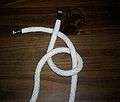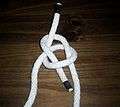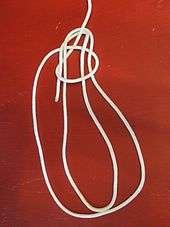Bowline
| Bowline | |
|---|---|
 | |
| Names | Bowline, boling knot (archaic) |
| Category | Loop |
| Origin | Ancient |
| Related | Sheet bend, double bowline, water bowline, Yosemite bowline, Spanish bowline, Portuguese bowline, triple bowline, bowline on a bight, running bowline, poldo tackle, Eskimo bowline, cowboy bowline |
| Releasing | Jamming |
| Typical use | Making a fixed loop in the end of a line |
| Caveat | While widely considered a reliable knot, when tied in certain materials or loading conditions it may not hold. |
| ABoK | #1010, #1716 |
| Instructions | |
The bowline (/ˈboʊlɪn/ or /ˈboʊlaɪn/)[1] is an ancient and simple knot used to form a fixed loop at the end of a rope. It has the virtues of being both easy to tie and untie; most notably, it is easy to untie after being subjected to a load. The bowline is sometimes referred as King of the knots because of its importance. It is one of the four basic maritime knots (the other three are figure-eight knot, reef knot and clove hitch).
The structure of the bowline is identical to that of the sheet bend, except the bowline forms a loop in one rope and the sheet bend joins two ropes. Along with the sheet bend and the clove hitch, the bowline is often considered one of the most essential knots.[2]
Although generally considered a reliable knot, its main deficiencies are a tendency to work loose when not under load, to slip when pulled sideways[3] and the bight portion of the knot to capsize in certain circumstances. To address these shortcomings, a number of more secure variations of the bowline have been developed for use in safety-critical applications.
History
The bowline's name has an earlier meaning, dating to the age of sail. On a square-rigged ship, a bowline (sometimes spelled as two words, bow line) is a rope that holds the edge of a square sail towards the bow of the ship and into the wind, preventing it from being taken aback.[4] A ship is said to be on a "taut bowline" when these lines are made as taut as possible in order to sail close-hauled to the wind.[5]
The bowline knot is thought to have been first mentioned in John Smith's 1627 work A Sea Grammar under the name Boling knot. Smith considered the knot to be strong and secure, saying, "The Boling knot is also so firmly made and fastened by the bridles into the cringles of the sails, they will break, or the sail split before it will slip."[6][lower-alpha 1]
Another possible finding was discovered on the rigging of the Ancient Egyptian Pharaoh Khufu's solar ship during an excavation in 1954.[7]
Usage
The bowline is used to make a loop at one end of a line. It is tied with the rope's working end also known as the "tail" or "end". The loop may pass around or through an object during the making of the knot. The knot tightens when loaded at (pulled by) the standing part of the line.
The bowline is commonly used in sailing small craft, for example to fasten a halyard to the head of a sail or to tie a jib sheet to a clew of a jib. The bowline is well known as a rescue knot for such purposes as rescuing people who might have fallen down a hole, or off a cliff onto a ledge. They would put it around themselves and sit on the loop. This makes it easy to heft them up away from danger. The Federal Aviation Administration recommends the bowline knot for tying down light aircraft.[8]
A rope with a bowline retains approximately 2/3 of its strength, with variances depending upon the nature of the rope,[9] as in practice the exact strength depends on a variety of factors.
In the United Kingdom, the knot is listed as part of the training objectives for the Qualified Firefighter Assessment.[10]
Tying
A mnemonic used to teach the tying of the bowline is to imagine the end of the rope as a rabbit, and where the knot will begin on the standing part, a tree trunk. First a loop is made near the end of the rope, which will act as the rabbit's hole. Then the "rabbit" comes up the hole, goes round the tree right to left, then back down the hole. This can be taught to children with the rhyme: "Up through the rabbit hole, round the big tree; down through the rabbit hole and off goes he." An alternative "lightning method" can also be used; see this animation.
-

The rabbit hole.
-

Out comes the rabbit,
-

runs around the tree,
-

and hops back into its hole.
-

Lightning method, tied on a ring. Pull per the blue arrows.
There is a potential with beginners to tie what is known as an Eskimo bowline. This faulty knot stems from an incorrect first step while tying the rabbit hole. If the loop is made backwards so that the end of the rope (the bitter end) is on the bottom, the resulting knot will be sideways. The final loop of a sideways bowline will slip. This makes it particularly dangerous in the case of an inexperienced sailor, who, in addition to having an insecure knot, is also less familiar with what to do should it come untied on the water.
Security
As noted above, the simplicity of the bowline makes it a good knot for a general purpose end-of-line loop. However, in situations that require additional security, several variants have been developed:
Round turn bowline
The round turn bowline is made by the addition of an extra turn in the formation of the "rabbit hole" before the working end is threaded through.
Water bowline
Similar to the double bowline, the water bowline is made by forming a clove hitch before the working end is threaded through. It is said to be stronger and also more resistant to jamming than the other variations, especially when wet.
Yosemite bowline
In this variation the knot's working end is taken round the loop in the direction of the original round turn, then threaded back up through the original round turn before the knot is drawn tight. The Yosemite bowline is often used in climbing.
Other variants

The cowboy bowline (also called "Dutch bowline"), French bowline, and Portuguese bowline are variations of the bowline, each of which makes one loop. (Names of knots are mostly traditional and may not reflect their origins.) A running bowline can be used to make a noose which draws tighter as tension is placed on the standing part of the rope. The Birmingham bowline has two loops; the working part is passed twice around the standing part (the "rabbit" makes two trips out of the hole and around the tree). Other two-loop bowline knots include the Spanish bowline and the bowline on the bight; these can be tied in the middle of a rope without access to the ends. A triple bowline is used to make three loops.[11] A Cossack knot is a bowline where the running end goes around the loop-start rather than the main part and has a more symetric triangular shaped knot. A slipped version of the cossack knot is called Kalmyk loop[12][13]
See also
Notes
- ↑ The orthography of this quote has been modernized for clarity.
References
- ↑ Random House Dictionary
- ↑ Cassidy 1985, The Klutz Book of Knots
- ↑ "How safe is the bowline knot in different situations?". The Great Outdoors. Retrieved 12 March 2013.
- ↑ Ashley, Clifford W (1944). The Ashley Book of Knots. Doubleday. p. 186.
- ↑ Kemp's Yachting Dictionary
- ↑ "The Seaman's Grammar and Dictionary (reprinting)" (PDF). Randal and Taylor. 1691. p. 25.
- ↑ Love, Kennett (1954-12-12), "Vessel of Cheops Appears Intact On Close Inspection From Above", New York Times, sec. 1, pp. 1,3,
...as well as a curiously intricate knot on a piece of rigging that appeared to be basically akin to a bowline knot.
- ↑ "Tiedown Sense". Advisory Circular (AC) 20-35C. Federal Aviation Administration. 7 December 1983. pp. 11–12.
- ↑ Dave Richards. "Knot Break Strength vs Rope Break Strength".
- ↑ Defence Fire Training and Development Centre. "Qualified Firefighter Assessment - Part 2 Training Objectives" (PDF). Archived from the original (PDF) on 2015-06-07.
- ↑ https://www.youtube.com/watch?v=4yL4izuwaxg 10 different bowlines quick in less than 3 min, slow repeat thereafter
- ↑ https://www.youtube.com/watch?v=wgJc1ymlYgg Tying video for Kalmyk loop
- ↑ https://www.youtube.com/watch?v=3Bl31rAWTcI Tying video for Kalmyk loop
External links
- Video of the Lightning Method
- Mark Gommers: An Analysis of Bowlines In-depth review of the bowline and its variants.
- YouTube animation of a Bowline knot